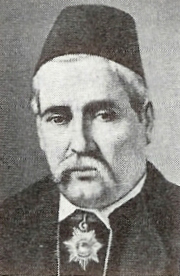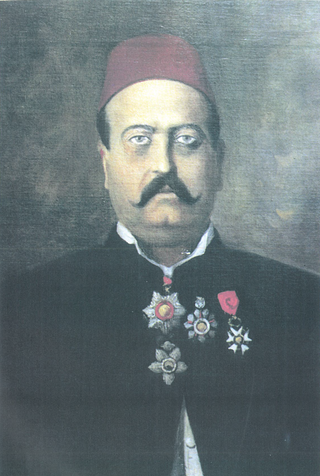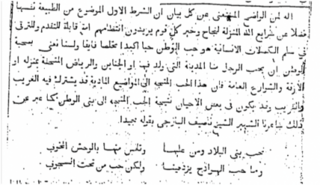Related Research Articles

Butrus al-Bustani was a writer and scholar from present day Lebanon. He was a major figure in the Nahda, which began in Egypt in the late 19th century and spread to the Middle East.
Al-Hadaf, is a Palestinian weekly political and cultural magazine published in Gaza City, Palestine. Established in 1969 the magazine was headquartered in different cities, including Beirut and Damascus.
The Nahda, also referred to as the Arab Awakening or Enlightenment, was a cultural movement that flourished in Arab-populated regions of the Ottoman Empire, notably in Egypt, Lebanon, Syria, and Tunisia, during the second half of the 19th century and the early 20th century.

Syrian nationalism, also known as Pan-Syrian nationalism, refers to the nationalism of the region of Syria, as a cultural or political entity known as "Greater Syria".

Nāṣīf bin ʻAbd Allāh bin Nāṣīf bin Janbulāṭ bin Saʻd al-Yāzijī was an author at the times of the Ottoman Empire and father of Ibrahim al-Yaziji. He was one of the leading figures in the Nahda movement.
George Percy Badger (1815–1888) was an English Anglican missionary, and a scholar of oriental studies. He is mainly known for his doctrinal and historical studies about the Church of the East.
The history of Middle Eastern newspaper publishing goes back to the 19th century. The Nahda was an important period for the development of newspaper publishing in the Middle East. During this period, a shift from government and missionary publishing to private publishing occurred. Especially in Egypt and Lebanon, newspapers became intertwined with daily life. Consequently, the rise of newspaper publishing impacted nationalism in Arab countries.
Lisan al-Hal or Lissan ul-Hal was a Lebanese Arabic language daily newspaper established by Khalil Sarkis in 1877 and is the oldest Lebanese publication still published in Lebanon.

Saleem Takla was a Lebanese-Ottoman journalist who founded of Al-Ahram newspaper with his brother Beshara Takla.

Al-Muqtaṭaf was an Arabic journal of popular science. The journal was published monthly from 1876 to 1952 in Beirut and Cairo with a total of 121 issues. Along with Al-Manar and Al-Hilal, it was one of the Arab world's three most popular journals in the early 20th century.
Thamarāt al Funūn was a Lebanese biweekly that was published between 1875 and 1908 in Beirut. It was one of the significant publications and the sole media outlet of the Lebanese Muslims during that period. It circulated regionally as part of the rising Arabic-language press of the mid-19th century.
Al Bashir was a Catholic magazine published in Beirut, Lebanon, by Jesuit. It was published triweekly from 1870 and 1947 and supported the Catholic religious cause in the region.
Al Hasnaa is an Arabic language women's magazine based in Beirut, Lebanon. The magazine has been in circulation since 1909.

Hadiqat al-Akhbar was a weekly newspaper which was published in Beirut in the period 1858–1911 with a two-year interruption. Its subtitle was Ṣaḥīfat Sūriyya wa-Lubnān. The paper was the first private daily in Beirut, the first Arabic newspaper which had a regular literary section and the first weekly Arabic newspaper in the region.
Al Hawadeth was a weekly news magazine which was published in Beirut, Lebanon, in the period 1911–2014 with some interruptions. The magazine is known for its publishers and editors: Salim Lawzi who was assassinated in March 1980, and Melhem Karam, who was a veteran journalist.
Faris Nimr, was a pioneer Lebanese journalist and intellectual. He cofounded Al Muqattam, an Arabic, Cairo-based newspaper.
Louis Sabunji (1838–1931) was a Catholic priest and political figure who founded and edited various publications, including Al Nahla. He was also one of the earliest photographers in Beirut.
Al Jawaib was a newspaper which existed between 1861 and 1884. The paper was founded by Ahmad Faris al-Shidyaq, a Lebanese journalist, and headquartered in Constantinople, Ottoman Empire. Over time it became the most popular Arabic publication in the Empire and made its founder known as a respected journalist and writer. In the last year of its existence the paper was published in Cairo.

Salim Al Bustani (1848–1884) was a Lebanese journalist, novelist and political figure who edited many publications with his father Butrus. He is known for being the pioneer of the genre of historical novel in Arabic.
References
- 1 2 Zachary Berman (February 2017). Owing and Owning: Zubayr Pasha, Slavery, and Empire in Nineteenth-Century Sudan (PhD thesis). The City University of New York. p. 81.
- 1 2 Rogier Visser (2014). Identities in early Arabic journalism: The case of Louis Ṣābūnjī (PhD thesis). University of Amsterdam. p. 5. hdl:11245/1.406149. ISBN 9789491164200.
- 1 2 3 4 5 Stephen Sheehi (28 May 2015). "The Life and Times of Louis Saboungi. A Nomadological Study of Ottoman Arab Photography". Ibraaz. Retrieved 21 May 2022.
- 1 2 3 4 5 6 7 8 L. Zolondek (January 1978). "Sabunji in England 1876-91: His Role in Arabic Journalism". Middle Eastern Studies . 14 (1): 102–115. doi:10.1080/00263207808700368.
- ↑ Doaa Adel Mahmoud Kandil (2016). "Abu Naddara: The Forerunner of Egyptian Satirical Press". Journal of Association of Arab Universities for Tourism and Hospitality. 13 (1): 24. doi: 10.21608/JAAUTH.2016.49733 .
- 1 2 Donald J. Cioeta (May 1979). "Ottoman Censorship in Lebanon and Syria, 1876-1908". International Journal of Middle East Studies . 10 (2): 170. doi:10.1017/S0020743800034759. S2CID 163019820.
- ↑ Albert Hourani (2013). Arabic Thought In The Liberal Age, 1798–1939 (22nd ed.). Cambridge; New York: Cambridge University Press. p. 269. doi:10.1017/CBO9780511801990. ISBN 978-0-521-27423-4.
- 1 2 Martin Kramer (2009). Arab awakening and Islamic revival: The politics of ideas in the Middle East (2nd ed.). New Brunswick, NJ; London: Transaction Publishers. p. 58. ISBN 978-1-4128-0767-8.
- ↑ Azmi Özcan (January 1993). "The Press and Anglo-Ottoman Relations, 1876-1909". Middle Eastern Studies. 29 (1): 116. JSTOR 4283543.